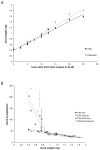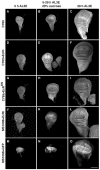The ecdysone receptor controls the post-critical weight switch to nutrition-independent differentiation in Drosophila wing imaginal discs
- PMID: 19515698
- PMCID: PMC2729347
- DOI: 10.1242/dev.032672
The ecdysone receptor controls the post-critical weight switch to nutrition-independent differentiation in Drosophila wing imaginal discs
Abstract
In holometabolous insects, a species-specific size, known as critical weight, needs to be reached for metamorphosis to be initiated in the absence of further nutritional input. Previously, we found that reaching critical weight depends on the insulin-dependent growth of the prothoracic glands (PGs) in Drosophila larvae. Because the PGs produce the molting hormone ecdysone, we hypothesized that ecdysone signaling switches the larva to a nutrition-independent mode of development post-critical weight. Wing discs from pre-critical weight larvae [5 hours after third instar ecdysis (AL3E)] fed on sucrose alone showed suppressed Wingless (WG), Cut (CT) and Senseless (SENS) expression. Post-critical weight, a sucrose-only diet no longer suppressed the expression of these proteins. Feeding larvae that exhibit enhanced insulin signaling in their PGs at 5 hours AL3E on sucrose alone produced wing discs with precocious WG, CT and SENS expression. In addition, knocking down the Ecdysone receptor (EcR) selectively in the discs also promoted premature WG, CUT and SENS expression in the wing discs of sucrose-fed pre-critical weight larvae. EcR is involved in gene activation when ecdysone is present, and gene repression in its absence. Thus, knocking down EcR derepresses genes that are normally repressed by unliganded EcR, thereby allowing wing patterning to progress. In addition, knocking down EcR in the wing discs caused precocious expression of the ecdysone-responsive gene broad. These results suggest that post-critical weight, EcR signaling switches wing discs to a nutrition-independent mode of development via derepression.
Figures







References
-
- Baker, N. E. (2007). Patterning signals and proliferation in Drosophila imaginal discs. Curr. Opin. Genet. Dev. 17, 287-293. - PubMed
-
- Beadle, G. W., Tatum, E. L. and Clancy, C. W. (1938). Food level in relation to rate of development and eye pigmentation in Drosophila melanogaster. Biol. Bull. 75, 447-462.
-
- Britton, J. S. and Edgar, B. (1998). Environmental control of the cell cycle in Drosophila: nutrition activates mitotic and endoreplicative cells by distinct mechanisms. Development 125, 2149-2158. - PubMed
-
- Britton, J. S., Lockwood, W. K., Li, L., Cohen, S. M. and Edgar, B. A. (2002). Drosophila's insulin/P13-kinase pathway coordinates cellular metabolism with nutritional conditions. Dev. Cell 2, 239-249. - PubMed
-
- Brogiolo, W., Stocker, H., Ikeya, T., Rintelen, F., Fernandez, R. and et al. (2001). An evolutionarily conserved function of the Drosophila insulin receptor and insulin-like peptides in growth control. Curr. Biol. 11, 213-221. - PubMed
Publication types
MeSH terms
Substances
Grants and funding
LinkOut - more resources
Full Text Sources
Molecular Biology Databases

